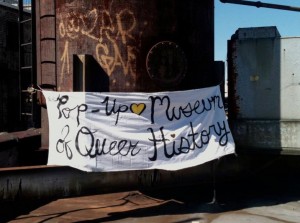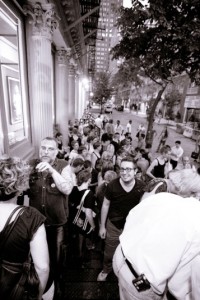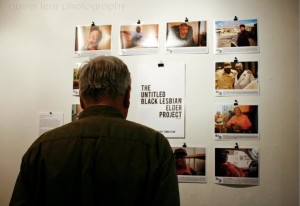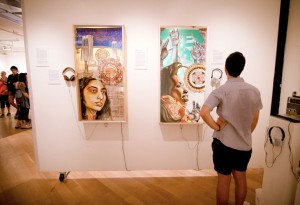Making history cool: The Pop-up Museum of Queer History
29 July 2013 – Hugh Ryan
 I founded the Pop-Up Museum of Queer History by accident. Originally, the idea was for a one-night party in my apartment in January of 2011, designed to create a for-us, by-us space where queer people could join together to celebrate ourselves as a valid public, worthy of speaking to; a valid subject, worthy of speaking about; and a valid authority, worthy of speaking on our own terms. But when a few Facebook postings generated nearly 30 exhibits–and over 300 attendees–I realized that what had started as a party had the potential to become something more.
I founded the Pop-Up Museum of Queer History by accident. Originally, the idea was for a one-night party in my apartment in January of 2011, designed to create a for-us, by-us space where queer people could join together to celebrate ourselves as a valid public, worthy of speaking to; a valid subject, worthy of speaking about; and a valid authority, worthy of speaking on our own terms. But when a few Facebook postings generated nearly 30 exhibits–and over 300 attendees–I realized that what had started as a party had the potential to become something more.
A few of us began holding meetings to define just what “The Pop-Up Museum” was. Eventually, we came up with this as our mission statement:
The Pop-Up Museum of Queer History develops exhibitions and events that engage local communities in conversations about queer pasts as a way to imagine queer futures. We provide a forum to do what we’ve always done: tell our own stories. We are artists, historians, educators and activists and we believe you are too.

The line outside the 2012 opening at Leslie Lohman Museum of Gay and Lesbian Art. (Photo: Tinker Coalescing)
Since that time, we’ve had five major shows across the country, run a series of professional development workshops for K-12 history teachers, and are currently gearing up for our sixth show, an exploration of the queer histories of the Brooklyn waterfront, which will take place this fall. With time and experience, I’ve discovered the many strengths (and occasional drawbacks) that the pop-up format brings to the exploration of public history. Here, in no particular order, are a few of the major ones.
- It’s All About the Money – As a small, new organization, we’ve never had much money. So we had to be creative about our use of space. The pop-up format has allowed us to get many spaces donated for free, because we use them for such short periods of time. So far, we’ve used community centers, college buildings, private apartments, galleries, and public spaces. We’ve also looked into (although have yet to use) retail/business spaces that are temporarily between tenants, religious centers, and elementary/secondary schools. The more creative a list of places you can brainstorm, the more likely you are to find a host – and the more surprising and delightful your eventual home will be.
- Stay Fresh – Queer history is fertile and contested ground at the moment. Our history, as a field, is being defined and codified for a mainstream audience, a process that is as exciting as it is nerve-wracking. Invariably, this mainstreaming comes with a whittling down that reduces queer history to a few touchstone moments. With our pop-up format, we saw right away that our shows would change frequently. If a traditional museum looks to tell the one story that stands in for a thousand, the Pop-Up Museum looks to tell all one thousand stories, messy and conflicting though they may be. No two of our shows ever look the same.
- Be Cool – At our first major Pop-Up show, gay historian George Chauncey said to those of us who organized it, “You’re making history cool.” Aside from being what I will have etched on my tombstone, I think this gets at the heart of what makes a pop-up format so well suited to the work of public history. By definition, something that is time-delimited comes with a feeling of scarcity–see it now or never–and this can work in your favor in terms of getting bodies in the room. Much of historical education in this country seems intended to deaden history as a subject, and present it in the driest, dullest terms possible. Part of our work as public historians is not just teaching specific content, but also showing the public a different, livelier, more engaged way to approach history. Our shows always begin with a kick-off party, featuring performances, food and drink, and at least some interactive history pieces for people to explore and take part in. We want our community to understand that this is our history, and it is amazing.
- Know What Happens Next – Because the Pop-Up Museum has no permanent home, and most of the spaces we work with do not consider themselves archives, the question of what happens to our exhibits after our shows is difficult – and one we didn’t consider until midway through our first major exhibition. Part of our mission is to help all queer people consider themselves worthy of speaking about history, even if it’s just those parts of history they themselves have personally experienced. This means that many of our exhibits are created specifically for our shows, by individuals who don’t consider themselves historians or artists – and thus have no plans for their piece after our show ends. By establishing working relationships with archives, libraries, museums, and galleries, we’re able to give a second life to some exhibits, but this is definitely an area we want to continue working on.
~ Hugh Ryan

Untitled Black Lesbian Elders Project (by Tiona M. and Lisa C. Moore) at Philadelphia show in 2012 (Photo: Queer Lens Photography)
For more images, visit the Pop-up Museum of Queer History’s Flickr stream.





A very interesting piece with some really great ideas. Inspiration for my own pop-up museum! Have you considered having an online archive of some of the material you collect for your exhibitions? Obviously, it’s a different format and you wouldn’t be able to accommodate everything, but it could be one way of preserving the stories you’ve collected and make them accessible to even more people. If you have considered it and decided against it, I’m curious whether this is something that you have found to be difficult, i.e. translating a tactile, multi-dimensional exhibition into an online space.
Molly – you’ve hit the nail right on the head! Creating a digital archive (or as we’ve been calling it, a virtual museum) has been one of our goals from day 1 of this project. But the difficulty in translating our tactile, three-dimensional, and often interactive pieces into web-ready exhibits has so far kept this project on the back burner. We’ve done basic cataloging and photographing (some of which can be found on our Flickr account – QueerMuseum), but if and when we do create a real virtual museum, we’d like it to be more than simply a slideshow. Have you seen any organizations that you would say have successfully created this kind of digital presence from a bricks-and-mortar public history exhibit?